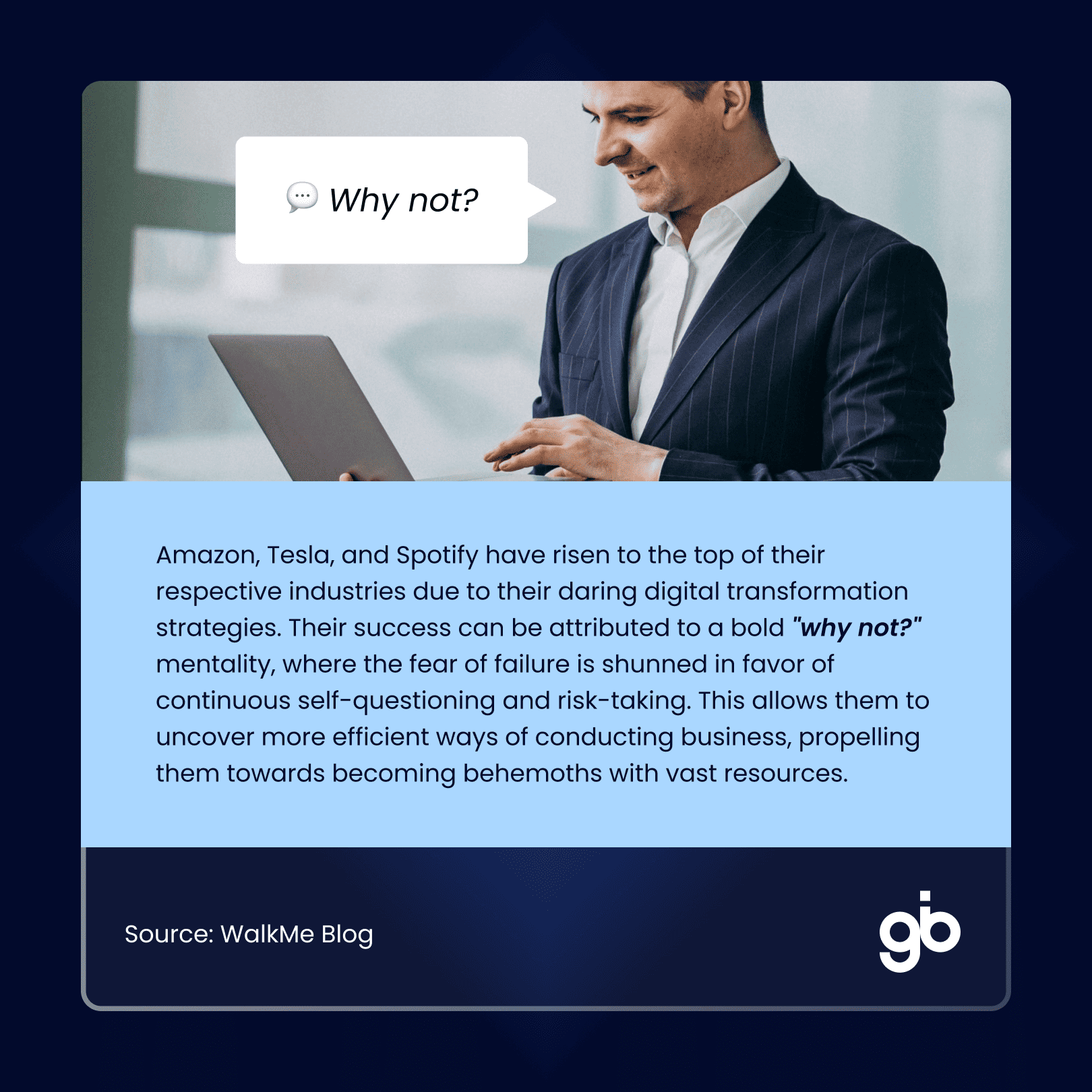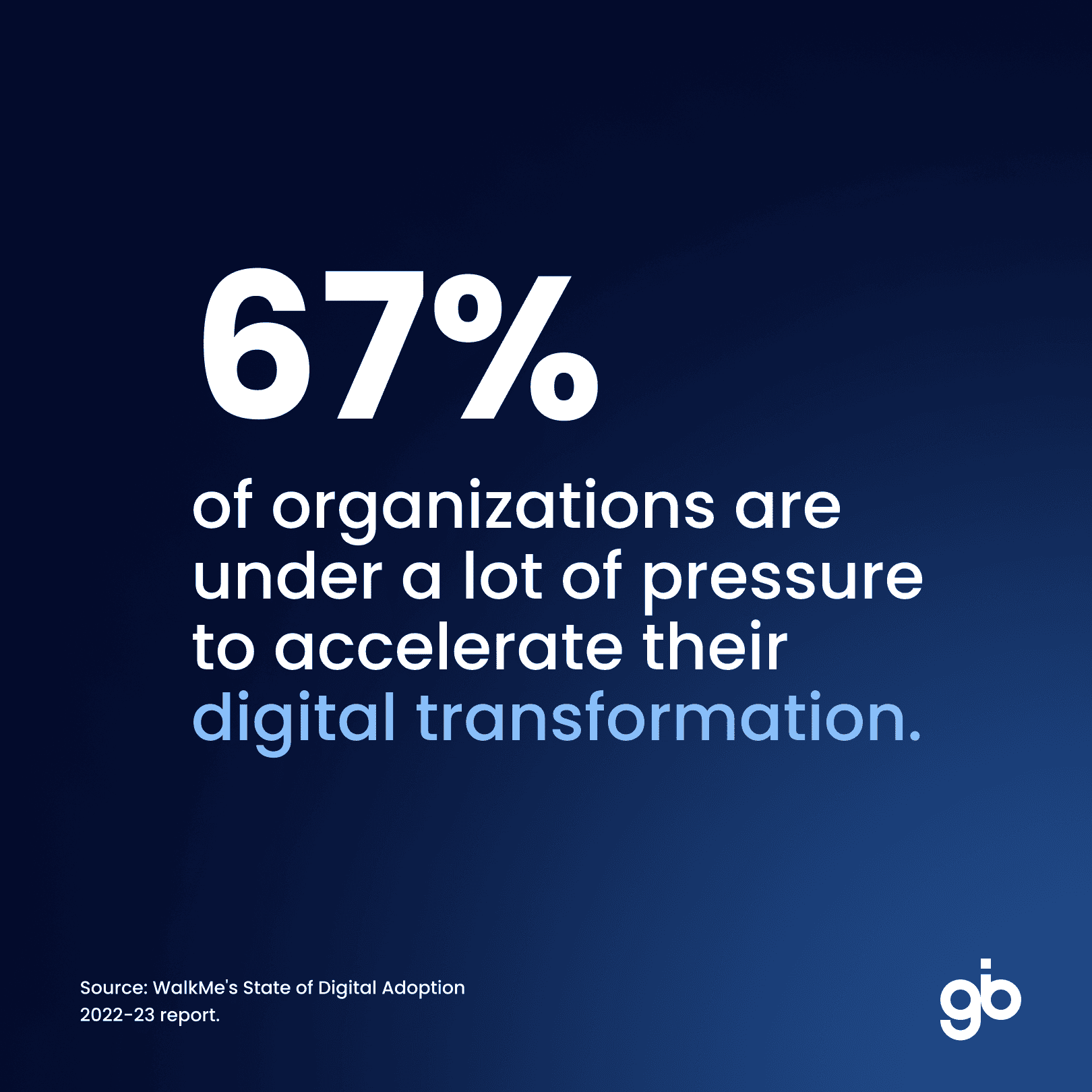In today’s marketplace, standing still is the fastest way to go backward. As technology continues to advance, companies must adapt and evolve to stay relevant. This is where the power of a digital transformation strategy comes into play.
But what does it mean to undergo this change? And more importantly, how can your company leverage this concept to thrive in an increasingly competitive landscape?
Whether you’re a small business or an established corporation, this article will provide you with the tools and knowledge you need to make a successful digital transformation. We’ll explore the benefits, debunk common myths, and provide practical steps to help you implement this strategy in your organization.
Let’s start by looking at what this process is all about:
What is a digital transformation strategy?
A digital transformation strategy is the foundation of technological innovation at the corporate level. This process encompasses all initiatives to be prioritized and focuses on individual success criteria.
Although creating such a strategy is a multi-stage process, it is certainly worth the effort. This is mainly because this process does not focus on the industry itself, but on the key areas of your company, as shown below:
Improve the customer experience: today’s technology can be a great ally when it comes to improving the experience we offer to our clients. Customer loyalty and retention play a key role in achieving this goal.
More satisfied employees: implementing new technologies not only benefits consumers but also brings great advantages to employees. They will be able to have a better understanding which will help them develop additional skills that will boost their professional growth.

Facilitates data analysis: creating reports with the KPIs of your business is the best way to know the current situation of your company. In addition, by having this information you can streamline decision-making and build better business objectives.
Keeps you up to date: having obsolete systems and technologies contributes to companies losing their competitive advantage. Thus, it is vital to ask yourself “How to build a digital transformation strategy that implements new and improved business processes?”. Performing this analysis is vital to unlock the full potential of your company and discover new business opportunities.
Now that we know in depth what this concept works, we will show you the steps to implement it in your business:
Steps to create a digital transformation strategy
1. Evaluate your digital environment
Start by examining the technologies you currently use in your company and the functions they perform. Then identify the most important silos and tasks in your organization.
With this information, you will be able to select the digital products or services that will help you solve these needs. By doing so, you will be able to increase efficiency and optimize your customers’ experience.
Similarly, it is important to follow a structured process to evaluate your technology environment as you move forward with your digital transformation strategy.
To determine how much you are using technology in your company, we recommend asking yourself the following questions:
- Do I need to optimize routine processes to improve my efficiency?
- Is keeping track of time and money vital to making more informed decisions?
- Do I need to streamline customer requests?
Knowing this information will help you choose a technology that not only improves the customer experience but also drives the growth of your business.
2. Establish goals and objectives to enhance your digital transformation strategy.
The key to implementing a successful digital transformation strategy is to show your employees the immense potential of making this change. By being clear about the benefits, your entire team will be aligned toward the same goal. Thus, you will be able to monitor progress to make sure it is on track.
In addition, by having your objectives and goals well defined, you will be able to optimize your resources and avoid additional expenses. Which, in the end, can negatively impact your budget.
Here are several types of goals you can implement:
- Increase revenue.
- Adopt greater agility.
- Optimize collaboration.
- Reduce software costs.
- Gain a competitive advantage.
- Increase employee productivity.
- Improve customer experience.
- Increase governance and compliance.

3. Create a roadmap adapted to your digital transformation strategy
To create a successful digital transformation strategy, you must understand your business needs and identify the weaknesses in your current technology. This will allow you to develop a strategic plan that will optimize your processes in an organized and effective way.
Another factor to consider is deadlines. By setting achievable deadlines with measurable KPIs and checkpoints, you will be able to effectively identify the success or failure of your efforts. Therefore, we recommend dividing your work plan into three sections:
Business models: implementing new business models can offer several advantages, such as the creation of new products, and increased prospect acquisition and will bring more value to your organization.
Customer experience: today’s consumers expect to get what they need when they need it. Thus, delivering an exceptional customer experience is critical for companies to stay competitive.
Operational processes: integrating today’s technology into your business is one of the critical objectives of a digital transformation strategy. Since it improves the way your company operates and allows you to offer more value to your customers.
4. Create an engaging user experience
If you don’t provide your customers with an engaging and accessible experience when using your products, you are likely to lose them to the competition.
By updating your user experience you show your customers that you want to offer them a fresh and updated service while presenting your strategic vision to your prospects.
Therefore, you must use the data collected throughout your organization to create a complete picture of your customers’ patterns, preferences, and needs. By analyzing this information you will be able to create a strategy that brings more value to consumers.
5.- Use automation whenever possible
If we consider the digital transformation strategy as an expedition, a crucial question arises for organizations and leaders: What to do once we reach our destination? Here, automation plays a key role in clarifying this question.
As your company reaches its proposed goals, process automation will allow you to streamline the creation of new services, products, and data flows. Therefore, we can see automation as the foundation that allows digital transformation to leave a significant footprint after its initial triumphs.
6. Invest in the right technologies
Human talent is the engine that will allow you to implement your digital transformation strategy. Therefore, you must select digital tools that will help you enhance your team’s work.
In this sense, an ITSM tool in the cloud is an excellent option to implement in your business. This system will help you streamline not only your customers’ requests but also increase employee efficiency. Project management software is also a key element in this process, as it facilitates the tracking and execution of your team’s tasks.
Likewise, you must ensure that all your employees are familiar with the new technologies. Thus, you must explain their purpose before buying them, answer their questions, and offer them adequate training. This will help you ensure a good ROI.
7. Constantly analyze your processes
The essence of a digital transformation strategy is to embrace change, so it is of utmost importance that you periodically analyze your progress. Below, we show you how continuous monitoring of your tasks can help to enhance this change:
Identifying problems: by monitoring your processes regularly, you can identify any incidents early. This will allow you to correct problems before they become major obstacles.
Improved decision making: data collected through constant monitoring can help you make more informed decisions. For example, you can decide where to invest more time or resources based on what is producing the best results.
Performance evaluation: by knowing how your processes are working, you can evaluate their performance against the KPIs and objectives of your strategy. This can help you demonstrate the value of your efforts and justify future investments in digital technology.

8. Adjusts the digital transformation strategy when necessary
The secret to creating a successful digital transformation strategy is to have an agile approach from the start. This way, you can adjust your objectives on the fly and get the desired results.
One way to achieve this goal is to divide the work into small tasks. This way, you can easily monitor your progress. It is also important that you maintain good communication with your team and get their feedback.
Applying these approaches will make it easier to identify and manage risks. Which will help you better manage your resources and keep the project on track.
Conclusion
Digital transformation is not just about adopting new technologies. It is a process that starts with people. Without their willingness and readiness to embrace change, even the best planning can fail.
The success of a digital transformation strategy depends heavily on fostering innovation, learning, and adaptability. It requires a culture that encourages curiosity, risk-taking, and continuous improvement.
Remember that technology is just the vehicle, it is the people who will drive your organization towards digital maturity. Thus, you must invest in the training of your team, and their skills to cultivate in your company a culture open to change.
If you are interested in learning more about this topic or want to start the digital transformation of your business, contact us. Our team of experts is ready to help you.



